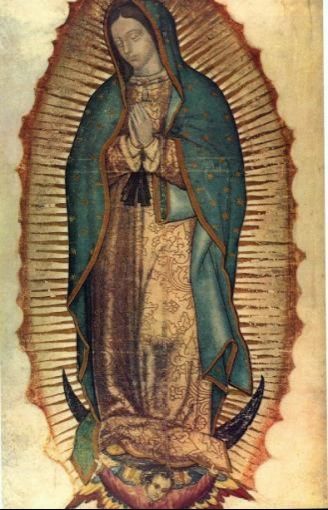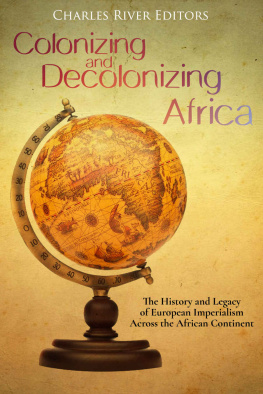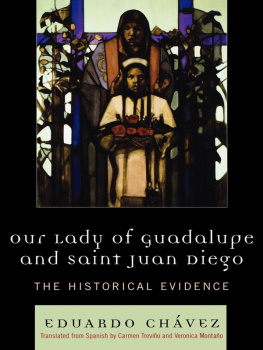The Virgin of Guadalupe: The History and Legacy of One of the Catholic Churchs Most Venerated Images
By Gustavo Vzquez-Lozano & Charles River Editors

About Charles River Editors

Charles River Editors is a boutique digital publishing company, specializing in bringing history back to life with educational and engaging books on a wide range of topics. Keep up to date with our new and free offerings with this 5 second sign up on our weekly mailing list , and visit Our Kindle Author Page to see other recently published Kindle titles.
We make these books for you and always want to know our readers opinions, so we encourage you to leave reviews and look forward to publishing new and exciting titles each week.
Introduction

Our Lady of Guadalupe
"In the beginning when the Christian faith had just arrived here in the land that today is called New Spain, in many ways the heavenly lady, the consummate Virgin Saint Mary, cherished, aided and defended the local people so that they might entirely give themselves and adhere to the faith .. in order that they might invoke her fervently and trust in her fully, she saw fit to reveal herself for the first time to two [Indian] people here."
No other artwork in the world is comparable to the Virgin of Guadalupe. What makes this painting unique located in the Basilica of Guadalupe, north of Mexico City is not precisely its artistic quality, as is the case with the Mona Lisa by Leonardo or The Kiss by Gustav Klimt, nor its place in the evolution of painting. It clearly does not constitute a landmark in art history, and the most visited painting in the world is certainly not the summit or the harbinger of a new aesthetic movement, like Dalis melting watches or Van Goghs Starry Night . In fact, for some, the execution of the image is coarse and all its elements fit well known techniques. For others, its merely a copy of a sculpture of the Virgin found in Spain.
What distinguishes the Virgin of Guadalupe of Mexico is her universality: unlike any work of art in the world, it can be recognized by any local; its certainly the most ubiquitous symbol in her country. It would be difficult to find a Mexican who cannot name her. Likewise, it would be complicated to find one who hasnt been at least once in his or her life before the image at the Basilica, either reluctantly or filled with devotion. The other thing that makes the Virgin of Guadalupe incomparable is her power to unite her nation, something that has been widely demonstrated throughout history. At different moments, and raised by different hands, the Virgin of Guadalupe (never the original painting) has led the troops that changed the history of the territory now known as Mexico. Not even a few hours had passed after the start of the War of Independence when the rebel army was already carrying the image of Guadalupe; in the twentieth century the image was present at the indigenous rebellion in Chiapas in 1994 and also materialized during the Mexican "perestroika" of 2000, which ended the single-party regime that had lasted for seven decades. Going further back, during Mexicos Conquest, Hernn Corts carried an image of the Virgin that, to the disinterested observer, is obviously the prototype of the Mexican Madonna.
For some, Guadalupe is the work of a talented Indian painter, and this work was retouched and embellished by others in later centuries. The majority of scholars note how the image "appeared" at a very convenient time in Mexicos history, when evangelization functioned as the ideological arm of the material conquest of the Aztec empire. There are even reasons to wonder whether the image currently on display in Mexico City is the same as in the 17 th century since it is known from testimonies of the time that Mary had a crown on her head. That means if its the same, at the very least its been retouched, doctored and tampered with again.
Conversely, for the believers, the image was miraculously stamped on the tilma or cloak of a man named Juan Diego. Among the latter are most of the 17 million persons who visit the original every year in Mexico City, which makes it the most visited painting in the country, and certainly the world. By comparison, the Mona Lisa at the Louvre in Paris receives six million visitors per year.
Historical fact or pious legend, Mexicans dont take the story as a joke. Until recently a saying circulated in Mexico that only two things were untouchable in the country: the President and the Virgin of Guadalupe. That said, the Lady of Tepeyac However, its not uncommon for those in prison for violent crimes to have the image tattooed on their backs for protection, and nobody feels offended, nor by the fact that some drug traffickers carve her image on the gold handles of their revolvers.
What nobody questions believers, skeptics or atheists is that the Virgin of Guadalupe has been the most important symbol, religious or not, in Mexicos history, a kind of non-official flag. Her influence has spread even to the Mexican diaspora, where it has become a sign of identity, pride and resistance among undocumented immigrants in the United States. For Mexicans, its not necessary to be religious to believe in the power of the Virgin of Guadalupe as a unifying symbol and embodiment of national identity. In only a few years, the image will reach the respectable age of half a millennium, if it was indeed painted in the traditionally assigned date. 500 years later, how much it is verifiable and how much of it is legend? What social role has the icon had, and how has it impacted Mexican politics? In the end, to tell the story of the brown-skinned Virgin, neither Indian nor Spaniard, is to observe the birth and development of a nation called Mexico, erected by the European sword and cross over the ruins of the Aztec empire.
The Virgin of Guadalupe: The History and Legacy of One of the Catholic Churchs Most Venerated Images looks at the history of the image, from the purported miracle to the major changes that took place across Mexico over the past few centuries. Along with pictures of important people, places, and events, you will learn about Our Lady of Guadalupe like never before.
Chapter 1: The Apparitions and Miracle
Its a well-known fact that visions of the Virgin Mary are a constant phenomenon in the Christian world, especially in Mediterranean countries such as Spain, Portugal, France and Italy. The Catholic, Anglican and Coptic churches have investigated hundreds of cases, although only a few have been officially recognized. The best known are the apparitions at Fatima (Portugal), Lourdes (France) and Mexico City in the 16 th century, but in none of the former cases, so say the believers, happened anything as extraordinary as over the ruins of the Aztec empire. According to true believers, the Virgin not only appeared, she left her image as proof of her presence for the people of the Americas of every age.
The story goes that in 1531, the Virgin Mary appeared four times on the outskirts of Mexico City to a poor Indian named Juan Diego. Juan Diego was a 57 year old man at the time, and despite the Spanish name, he was actually of pure Native American origin and had grown under Aztec rule. His original name was Cuauhtlatoatzin (Eagle that Speaks), and he was born in Cuautitln (now a municipality in the northern section of greater Mexico City).


















